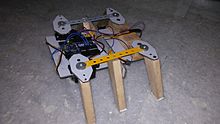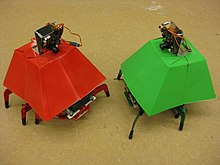Hexapod (robotics)
This articleneeds additional citations forverification.(May 2010) |
A six-legged walking robot should not be confused with aStewart platform,a kind ofparallel manipulatorused in robotics applications.

Ahexapodrobot is a mechanicalvehicle that walkson six legs. Since a robot can be statically stable on three or more legs, a hexapod robot has a great deal of flexibility in how it can move. If legs become disabled, the robot may still be able to walk. Furthermore, not all of the robot's legs are needed for stability; other legs are free to reach new foot placements or manipulate a payload.
Many hexapodrobotsarebiologicallyinspired byHexapodalocomotion– theinsectoid robots.Hexapods may be used to test biological theories about insect locomotion, motor control, and neurobiology.
Designs[edit]

Hexapod designs vary in leg arrangement. Insect-inspired robots are typically laterally symmetric, such as the RiSE robot at Carnegie Mellon.[1]A radially symmetric hexapod is ATHLETE (All-Terrain Hex-Legged Extra-Terrestrial Explorer) robot atJPL.[2]
Typically, individual legs range from two to sixdegrees of freedom.Hexapod feet are typically pointed, but can also be tipped with adhesive material to help climb walls or wheels so the robot can drive quickly when the ground is flat.
Locomotion[edit]

Most often, hexapods are controlled by gaits, which allow the robot to move forward, turn, and perhaps side-step. Some of the most common gaits are as follows:
- Alternating tripod: 3 legs on the ground at a time.
- Quadruped.
- Crawl: move just one leg at a time.
Gaits for hexapods are often stable, even in slightly rocky and uneven terrain.
Motion may also be nongaited, which means the sequence of leg motions is not fixed, but rather chosen by the computer in response to the sensed environment. This may be most helpful in very rocky terrain, but existing techniques formotion planningare computationally expensive.
Biologically inspired[edit]
Insects are chosen as models because theirnervous systemare simpler than other animal species. Also, complex behaviours can be attributed to just a fewneuronsand the pathway between sensory input and motor output is relatively shorter. Insects' walking behaviour and neural architecture are used to improve robot locomotion. Conversely,biologistscan use hexapod robots for testing different hypotheses.
Biologically inspired hexapod robots largely depend on theinsectspecies used as a model. Thecockroachand thestick insectare the two most commonly used insect species; both have beenethologicallyandneurophysiologicallyextensively studied. At present no completenervous systemis known, therefore, models usually combine different insect models, including those of other insects.
Insect gaits are usually obtained by two approaches: the centralized and the decentralized control architectures. Centralized controllers directly specify transitions of all legs, whereas in decentralized architectures, six nodes (legs) are connected in a parallel network; gaits arise by the interaction between neighbouring legs.
List of robots[edit]
See also[edit]
References[edit]
- ^"RiSE robot".Carnegie Mellon University.
- ^"ATHLETE".JPL. Archived fromthe originalon 2006-09-29.

